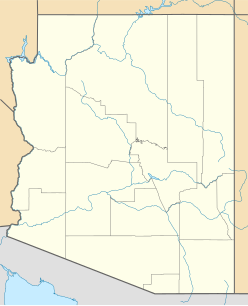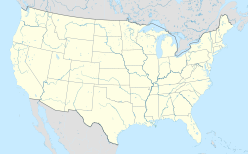Predloga:Infopolje Lokacija trka na Zemlji/dok
| To je dokumentacijska podstran za glavno stran Predloga:Infopolje Lokacija trka na Zemlji. Namenjena je shranjevanju navodil, kategorizaciji in drugi vsebini, ki ni del glavne strani. |
| Uporablja Lua: |
This infobox documents a terrestrial impact site, an impact crater or impact structure on Earth (separate templates exist for impact sites on the moon and other planets).
Uporaba
[uredi kodo]Fields should generally be directly from the source, such as the Earth Impact Database or Impact Field Studies Group impact list. Wikilinks and expansion of abbreviations are acceptable.
Impact crater/structure theories which have been disproven or are considered to have low confidence should not use this infobox. Editors are encouraged to remove the infobox from disproven/unlikely crater theory pages immediately without waiting to ask for permission.
Example infobox
[uredi kodo]The following parameters can be used to create a terrestrial impact site infobox. Please remove any parameters that are not likely to be useful.
{{Infopolje Lokacija trka na Zemlji
| name = <!-- mandatory -->
| other_name =
| photo =
| photo_size =
| photo_alt =
| photo_caption =
| map =
| map_alt =
| map_caption =
| map_size =
| location =
| label =
| label_position =
| coordinates =
| coordinates_ref =
| confidence = <!-- mandatory -->
| diameter =
| depth =
| rise =
| imp_size =
| age =
| exposed =
| drilled =
| bolide =
| translation =
| language =
| pronunciation =
| topo =
| access =
| country =
| state =
| province =
| district =
| municipality =
}}
Parameter documentation
[uredi kodo]| Field | Description |
|---|---|
| name | Name of the impact site. This field is required. |
| other_name | Other name for the impact crater or structure if relatively well known. For example, Meteor Crater for Barringer Crater. Quotes can be used as normal to italicize or bold the text if desired. |
| photo | Photograph of the crater or structure. Preferably this should be a distance or aerial shot to show most/all of the crater or structure rather than a view from within it. Do not include the "File:" prefix. If uploading a new image, please put them on Commons so they can be easily used by the other language Wikipedias. If the only image available is less than 300px wide, you can use the photo_size parameter to indicate its size. |
| photo_size | Specify the width of the photo in pixels. For example, photo_size = 200 with no "px". If no value is specified, the default width is 285 pixels. A standard horizontal photographic composition will generally display well at 285px. A standard vertical composition may need to be adjusted to 180 or 220 pixels.
|
| photo_alt | Alt text for the photo, primarily for visually impaired readers. See Wikipedia:Alternative text for images. |
| photo_caption | Description of the photograph which is displayed below. Include the month and year if known. |
| map | The name of a location map as per Template:Location map (e.g. Indonesia or Russia). The coordinate fields (e.g. lat_d and long_d) position a pushpin coordinate marker and label on the map automatically. Example see: Mount Everest |
| map_alt | Alt text for the map, primarily for visually impaired readers. See Alt text for maps and diagrams. |
| map_caption | Fill out if a map caption is desired. If not specified, location will be used. |
| map_size | Must be entered as only a number—no need for px. The default value is 250. |
| location | Province or state first, followed by country. For USA, the county is optional but if given, be provided before the state. If a pushpin map is being used, the location will be used for the map's caption unless the map_caption parameter is set. |
| label | Label to be used for the impact crater or structure's location on the map. If not specified, the value of the name parameter is used. |
| label_position | The position of the label on the pushpin map relative to the pushpin coordinate marker. Valid options are {left, right, top, bottom, none}. If this field is not specified, the default value is right. |
| coordinates | The latitude and longitude of the summit using the {{koord novi}} template with display=inline,title. If the article uses a geolinks template in the external links section, do not use the display parameter. |
| coordinates_ref | For any references regarding the coordinates reported. <ref> </ref> tags must be used. |
| confidence | If the reference is the Earth Impact Database then this field should be "confirmed". Otherwise, if from the Impact Field Studies Group impacts list, use the classification "confirmed", "most probable", "probable", or "possible". This should include a citation, such as from {{Cite Earth Impact DB}} (for confirmed impact sites). Do not list impact theories which have no listing, or are listed as "improbable", "rejected" or "proposed". Even if you see a story in the news, give the scientists time to classify them. This field is required. |
| diameter | Diameter of the impact crater or structure. Impact listings always use metric units. On Wikipedia, for the international audience, these listings should include a conversion to imperial units. |
| depth | Depth of the impact crater, in metric units. This listing should include a conversion to imperial units. |
| rise | Height of the crater rim above the surrounding area, if applicable, in metric units |
| imp_size | Size/diameter of the impact crater progenitor in kilometers/meters. |
| age | Age of the impact. Geologic time scales may be useful here. |
| exposed | "Yes" if the impact crater or structure is exposed at the surface. "No" if not. |
| drilled | "Yes" if the site has been drilled by geologists. "No" if not. |
| bolide | The type of bolide (impactor), if known. Examples include "chondrite" or "iron". Use what the source says. |
| translation | If the impact crater or structure name is not in English, the English translation. |
| language | The language of the translation. |
| pronunciation | Pronunciation of the name if not obvious. |
| topo | The name of the topographic map showing the impact crater or structure. In Canada, this is usually the National Topographic System map number while for the USA, it's the map name from the USGS. For large structures, it is probably not worthwhile to list. This should not be included for buried structures (since they won't appear on the topo map.) |
| access | The access route to the site. |
| country | The country where the impact crater or structure is located. |
| state | The state where the impact crater or structure is located. (This is mutually exclusive with province.) |
| province | The province where the impact crater or structure is located. (This is mutually exclusive with state.) |
| district | The district where the impact crater or structure is located. |
| municipality | The municipality where the impact crater or structure is located. |
General notes
[uredi kodo]- The name and confidence fields are required. Optional fields will not display if not present in the template or do not have any value.
Zgledi
[uredi kodo]Zgled 1
[uredi kodo]| Barringer Crater | |
 Meteor Crater, also known as Barringer Crater | |
| Udarni krater/struktura | |
|---|---|
| Nivo potrditve | Confirmed[1] |
| Premer | 1,186 km |
| Globina | 170 m |
| Rise | 45 m |
| Impactor diameter | 50 m |
| Starost | 50,000 years |
| Exposed | Yes |
| Drilled | Yes |
| Bolide type | Iron meteorite |
| Lega | |
| Lega | Coconino County, Arizona |
| Koordinati | 35°1′38″N 111°1′21″W / 35.02722°N 111.02250°W |
| Država | United States |
| Regija | US-AZ |
| Zvezna država | Arizona |
| Dostop | Interstate 40 |
| Razglasitev | November 1967 |
{{Infopolje Lokacija trka na Zemlji
| name = Meteor Crater
| other_name = Barringer Crater
| photo = Meteor Crater - Arizona.jpg
| photo_size =
| photo_alt =
| photo_caption = Meteor Crater, also known as Barringer Crater
| location = [[Coconino County, Arizona]]
| map = Arizona
| map_alt =
| map_caption = Location of Meteor Crater in Arizona
| map_size =
| label_position =
| coordinates = {{koord novi|35|1|38|N|111|1|21|W}}
| coordinates_ref =
| confidence = Confirmed<ref name="EID1">{{Cite Earth Impact DB | name = Barringer | accessdate = 2008-12-30 }}</ref>
| diameter = 1,186 km
| depth = 170 m
| age = 50,000 let
| exposed = Yes
| drilled = Yes
| bolide = [[Iron meteorite]]
| topo =
| access = [[Interstate 40 in Arizona|Interstate 40]]
| country = [[United States]]
| state = [[Arizona]]
| province =
| region = US-AZ
| district =
| municipality =
| module =
{{designation list |embed=yes |designation1=NNL |designation1_date=November 1967}}
}}
Zgled 2
[uredi kodo] Shatter cones at the side of Highway 475 in the Santa Fe impact structure | |
| Udarni krater/struktura | |
|---|---|
| Nivo potrditve | confirmed[2] |
| Premer | 6 km-13 km |
| Starost | less than 1.2 billion years |
| Exposed | no |
| Drilled | no |
| Lega | |
| Lega | Sangre de Cristo Mountains |
| Koordinati | 35°45′N 105°56′W / 35.750°N 105.933°W |
| Država | United States |
| Zvezna država | New Mexico |
| Okrožje | Santa Fe County |
| Dostop | SR475 northeast of Santa Fe |
{{Infopolje Lokacija trka na Zemlji
| name = Santa Fe impact structure
| other_name =
| photo = Kluft-photo-Shatter cones-Sep-2008-Img 1711.jpg
| photo_size =
| photo_alt =
| photo_caption = [[Shatter cones]] at the side of Highway 475 in the Santa Fe impact structure
| location = [[Sangre de Cristo Mountains]]
| map = ZDA
| map_alt =
| map_caption = Location of Santa Fe impact structure in New Mexico
| map_size =
| label_position =
| coordinates = {{koord novi|35|45|N|105|56|W|display = inline}}
| coordinates_ref =
| confidence = confirmed<ref name="EID">{{Cite Earth Impact DB | name = Santa Fe | linkname = santafe | accessdate = 2010-03-16 }}</ref>
| diameter = 6 km-13 km
| depth =
| age = less than 1.2 billion years
| exposed = no
| drilled = no
| bolide =
| topo =
| access = SR475 northeast of Santa Fe
| country = United States
| state = New Mexico
| region =
| district = [[Santa Fe County, New Mexico|Santa Fe County]]
| municipality =
}}
Sklici
[uredi kodo]- ↑ »Barringer«. Earth Impact Database. Planetary and Space Science Centre University of New Brunswick Fredericton. Pridobljeno 30. decembra 2008.
- ↑ »Santa Fe«. Earth Impact Database. Planetary and Space Science Centre University of New Brunswick Fredericton. Pridobljeno 16. marca 2010.
Microformat
[uredi kodo]HTML-koda, ki jo sestavi ta predloga, vključuje mikroformat hCard, ki omogoča strojno razčlenjevanje imen in naslovov, na primer za katalogiziranje člankov ali vključevanje podatkov o subjektu v adresar.
Znotraj hCarda mikroformat Geo, ki omogoča še strojno razčlenjevanje koordinat (zemljepisna širina in dolžina), zato jih je denimo možno preveriti na digitalnem zemljevidu ali spraviti v GPS-napravo.
Če opisujete kraj, ki ima datum ustanovitve oz. odprtja, uporabite {{Start date}}. Če ima spletno stran, uporabite {{URL}}.
Hcard uporablja naslednje razrede HTML:
- adr
- agent
- category
- county-name
- extended-address
- fn
- label
- locality
- nickname
- note
- org
- region
- street-address
- url
- vcard
Geo je produkt klica predloge {{koord}} in uporablja naslednje razrede HTML:
- geo
- latitude
- longitude
Prosimo, ne preimenujte ali odstranjujte teh razredov.
Ob podajanju koordinat se prosimo izogibajte pretirani natančnosti.
Sledilna kategorija
[uredi kodo]


